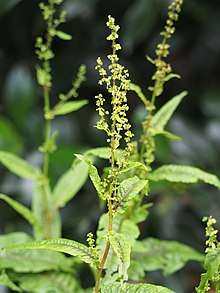Rumex sanguineus
Rumex sanguineus, commonly known as bloody dock or red veined dock,[1] is a perennial flowering plant species in the family Polygonaceae. Rumex sanguineus is a dicot and can be observed in Europe with at least two varieties [2]
| Rumex sanguineus | |
|---|---|
 | |
| Scientific classification | |
| Kingdom: | Plantae |
| Clade: | Tracheophytes |
| Clade: | Angiosperms |
| Clade: | Eudicots |
| Order: | Caryophyllales |
| Family: | Polygonaceae |
| Genus: | Rumex |
| Species: | R. sanguineus |
| Binomial name | |
| Rumex sanguineus | |
Description
The leaves are deciduous to partially persistent at maturity. The blade of the leaf is lance shaped with a pointed base at the end and on average measure 10-30 x2.5-6 cm. Flower is terminal and occupies the top 2/3 of the stem. Inflorescence is lax, interrupted, broadly paniculate. The leaves are situated to the base of the plant only.[3] The pedicel, stalk bearing the inflorescense, is proximal 1/3 and rarely in the middle of the filiform. In general, it is larger than the inner tepals with distinctly swollen articulation. When flowering there are normally 10- 20 flowers in lax remote whorls. Achenes are dark reddish brown almost black. Rumex sanguineus flower in the summer in moist and riparian habitat.
Distribution
Rumex sanguineus is not native to North America with most reports of Rumex sanguineus being confused with R. conglomeratus or immature R. obtusifolius. Rumex sanguineus is commonly found in Europe. It is a crop-weed that can be found on less arable fields on the outskirt vegetation surrounding arable fields.[4]
References
- "Rumex sanguineus var. sanguineus - Plant Finder". www.missouribotanicalgarden.org. Retrieved 2019-10-03.
- "Rumex sanguineus in Flora of North America @ efloras.org". www.efloras.org. Retrieved 2019-10-03.
- "Rumex sanguineus in Flora of North America @ efloras.org". www.efloras.org. Retrieved 2019-10-03.
- Groenman-Van Waateringe, W; Van Driel-Murray, C (April 15, 1980). "The Origin of Crop Weed Communities Composed of Summer Annuals". Vegetatio. 41 (2): 57–59. doi:10.1007/BF00121414. JSTOR 20145755.